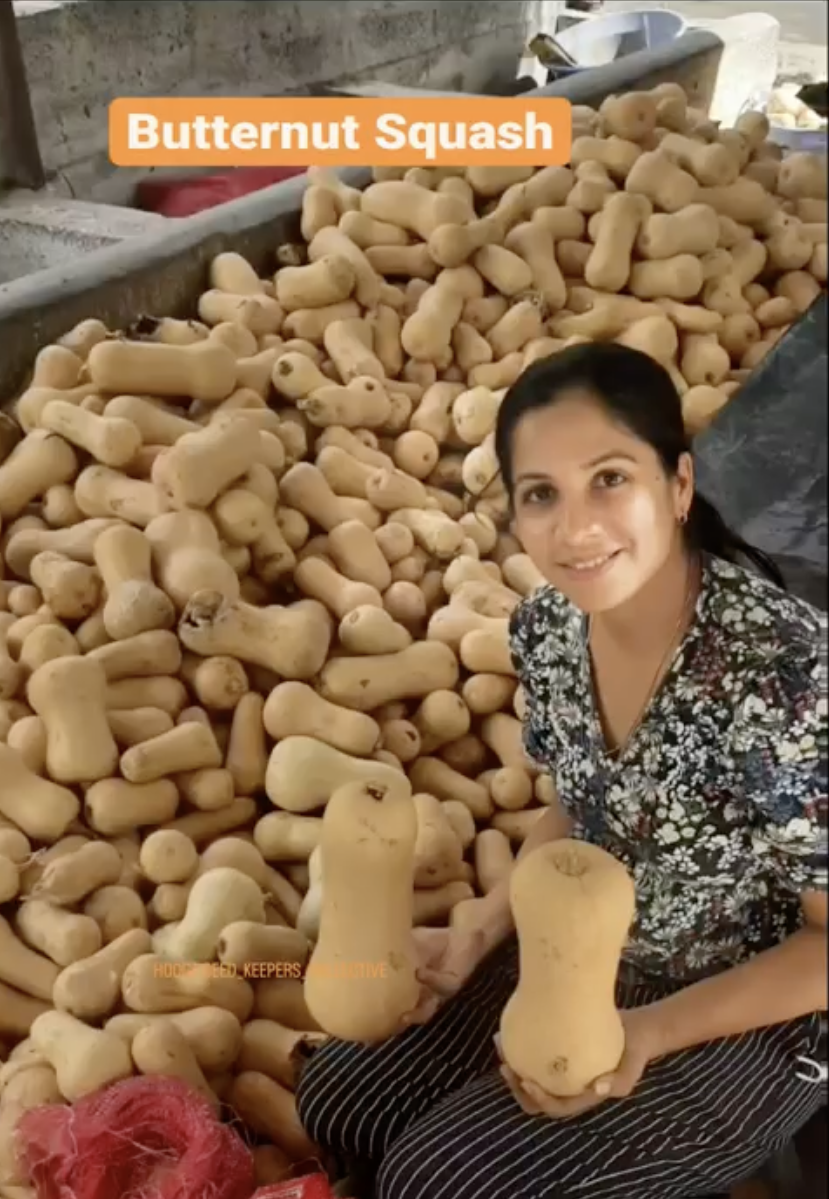Butternut Pumpkin (Squash Type)
₹120.00 Original price was: ₹120.00.₹100.00Current price is: ₹100.00.
Quantity: 20 seeds
Butternut pumpkin is prized for its flavor, versatility, and nutritional benefits, making it a popular choice in various cuisines around the world, especially during the fall and winter months when it’s in season
50 in stock
Category: Pumpkin Collection
Tags: #agricultureseedstore, #beej, #BiodiversityOfIndia, #buyseeds, #buyvegetableseeds, #chemicalfreeseeds, #ClimateChange, #ClimateResilientSeeds, #ClimateSmartFarming, #desibeej, #desiseed, #Desiseeds, #FarmStore, #heirloomseed, #heirloomseeds, #homegarden, #homegardeningseeds, #hoogafarms, #hoogaseedkeepers, #MaadiThottamseeds, #naatuvidhai, #nativefoods, #nativevegetableseeds, #naturalfarming, #NaturalFoods, #naturalseeds, #NonGMOseeds, #openpollinatedseeds, #opseeds, #organicfarming, #organicseeds, #RooftopGardening, #RooftopGardenseeds, #SaveNativeSeeds, #SaveOurSeeds, #SaveSeeds, #SayNoToGMO, #seedconservation, #seeddiversity, #seedfarm, #seedkeeperscollective, #seedKeepersNetwork, #seedsavers, #seedsaving, #seedshop, #SeedsOfIndia, #seedstore, #tamilseedsavers, #Terracegardenseeds, #traditionalseed, #traditionalseeds, #traditionalvegetableseeds, #vegetablediversity, #Vegetableseed, #vegetableseeds, #Vidhaigaleperayudham, Agriculture, Flower Pumpkin Seeds, hoogafarm, hoogaseed, hoogaseeds, hoogavidhai, madhurai poo parangi vidhai, Madurai Flower Pumpkin - Seeds, parangikai vidhai, poo parangikai, shop, shopping, Vidhai
Butternut pumpkin, also known simply as butternut squash, is a type of winter squash that belongs to the Cucurbitaceae family. Here are some key details about butternut pumpkin:
Characteristics and Appearance
- Shape and Size: Butternut pumpkin is pear-shaped with a long neck and bulbous bottom. It typically ranges in size from small to medium-large, weighing anywhere from 2 to 5 pounds (1 to 2.5 kg).
- Color: The skin of butternut pumpkin is smooth and thin, usually a creamy tan or beige color. The flesh inside is vibrant orange-yellow, dense, and smooth-textured when cooked.
Culinary Uses
- Flavor: Butternut pumpkin has a sweet and nutty flavor, making it versatile for both savory and sweet dishes.
- Cooking Methods: It can be roasted, baked, steamed, boiled, pureed, or used in soups, stews, curries, risottos, salads, and even desserts like pies and muffins.
- Nutritional Value: Butternut pumpkin is rich in vitamins A, C, and E, as well as dietary fiber and minerals such as potassium and magnesium. It is low in calories and fat, making it a nutritious addition to meals.
Growing Conditions
- Climate: Butternut pumpkins thrive in warm climates with full sun. They require a long growing season, typically around 75 to 100 days from planting to harvest.
- Soil: Well-drained, fertile soil with plenty of organic matter is ideal. They prefer slightly acidic to neutral soil pH.
Health Benefits
- Antioxidants: The orange-yellow flesh of butternut pumpkin contains beta-carotene, a powerful antioxidant that supports eye health and boosts the immune system.
- Fiber: High fiber content supports digestive health and helps regulate blood sugar levels.
- Vitamins and Minerals: Provides essential vitamins and minerals necessary for overall health and well-being.
Culinary Tips
- Preparation: To prepare butternut pumpkin, it’s often peeled, seeded, and then sliced or cubed for cooking. The seeds can also be roasted and enjoyed as a nutritious snack.
- Storage: Whole butternut pumpkins can be stored in a cool, dry place for several weeks. Once cut, store the unused portion in the refrigerator wrapped in plastic wrap for up to a week.
Butternut pumpkin is prized for its flavor, versatility, and nutritional benefits, making it a popular choice in various cuisines around the world, especially during the fall and winter months when it’s in season.
| Weight | 10 g |
|---|
Be the first to review “Butternut Pumpkin (Squash Type)” Cancel reply
Related products
Drumstick SuperShort Local
₹60.00Original price was: ₹60.00.₹50.00Current price is: ₹50.00. -17%100 varieties Combo
₹7,000.00Original price was: ₹7,000.00.₹6,150.00Current price is: ₹6,150.00. -12%Okra Seven Lines Seeds
₹150.00Original price was: ₹150.00.₹99.00Current price is: ₹99.00. -34%Small Pumpkin (Chittu Poosani)
₹150.00Original price was: ₹150.00.₹100.00Current price is: ₹100.00. -33%







Reviews
There are no reviews yet.